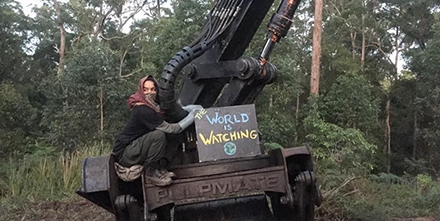Everyone who works in Australia – actually anywhere – should have the right to expect to work in a safe environment free of risk of injury or harm – physical and/or mental. That unalienable right is even enshrined in legislation across the country. But that legislation is challenged on a regular basis, in particular by those who seek to disrupt the timber industry. Repeatedly we see protestors chaining themselves to equipment and gates. Source: Bruce Mitchell
That’s bad enough. There are multiple situations there that could see someone accidently injured. Chances are it will be a protestor who is where they shouldn’t be. Chances are the timber industry, in the eyes of the protestors at least, will be labelled as the one at fault.
That hasn’t happened yes, and hopefully it never will.
But protestors chaining themselves to equipment is one thing.
Deliberately taking action what could endanger life is another.
In May last year two southern Tasmanian sawmills reported incidents of deadly tree spiking in Tasmanian forests.
The spiked logs destroyed saws worth up to $15,000. It could have been far worse.
And now this week we have Melina Bath, the Member for the Eastern Victoria Region, telling State Parliament of incidents where metal star pickets had been stuck in the ground on the access roads to a native timber coupe in Gippsland.
“If a car was to hit that, it could certainly damage the car but also potentially endanger life and cause serious injury,” Ms Bath said.
She quite rightly pointed out that there seems to be no real attempt by government to “stop these vigilante protesters really impeding and frustrating working operations”.
Both the Tasmanian incident last year and this latest act of bastardry need to be investigated, but they probably won’t be. Certainly, no charges will ever be laid.
Of course, it’s hard to prove who and why these tactics are being deployed. It’s easy to surmise, but hard to prove.
It is not made easier when Ms Bath raised the problem in State Parliament this week and only got buck passing between those who felt it was the Agriculture Minister’s problem and those who felt, like Ms Bath, that it was a problem for the Minister for Workplace Safety.
Eventually the Minister for Workplace Safety Ingrid Stitt agreed to “take the details of Ms Bath’s example and refer them to the correct minister in relation to those specifics of that workplace”.
Tasmania’s Resources Minister Guy Barnett is having a similar fight with the State’s Labor Opposition which appears to be stonewalling proposed Workplace Protection legislation.
Mr Barnett was backward in coming forward, laying the blame squarely on Labor’s closeness to the Greens.
And then we have Tasmania’s WorkSafe Tasmania which appears to have taken no action – so far – in relation to Forest & Wood Communities Australia’s two Incident Notifications it has lodged in reference to protest action taken by the Bob Brown Foundation.
It is worth noting, again, that the foundation, which is regarded as a business under the Work, Health and Safety Act, has a duty of care for the people it puts in harm’s way during protests.
Everyone who works in Australia should have the right to expect to work in a safe environment free of risk of injury or harm.
Get hit by a falling limb in a forest and the relative government authority will be all over the case. If it happens more than once, expect a possible prosecution.
Get chained to a harvester or logging truck in protest, and so far, nothing seems to happen.






